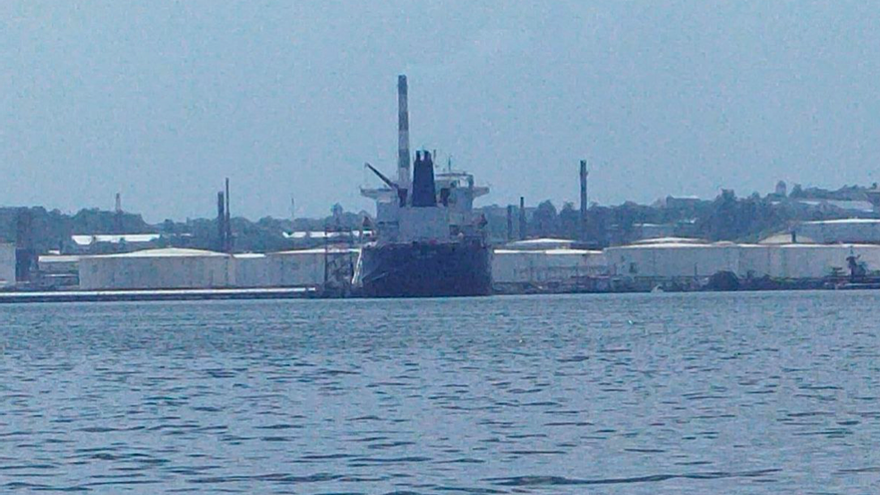
![]() 14ymedio, Havana, 5 July 5, 2023 — The oil tanker SCF Prime, with a Liberian flag and an approximate capacity of 530,000 barrels, arrived this Tuesday in the bay of Havana from the Russian port of Tuapse. It is the first tanker to arrive on the Island after the oil supply agreement between Russia and Cuba and, although it was scheduled to unload in Matanzas on July 2, it ended up arriving in the capital.
14ymedio, Havana, 5 July 5, 2023 — The oil tanker SCF Prime, with a Liberian flag and an approximate capacity of 530,000 barrels, arrived this Tuesday in the bay of Havana from the Russian port of Tuapse. It is the first tanker to arrive on the Island after the oil supply agreement between Russia and Cuba and, although it was scheduled to unload in Matanzas on July 2, it ended up arriving in the capital.
Through the maritime monitoring websites, this newspaper followed the trajectory of the ship from its departure from Tuapse, on June 3, until it reached the Cuban coast a month later, on July 4. The ship disappeared from radar and does not appear on the lists of ships anchored in any Cuban port.
However, the photographs captured this Tuesday by 14ymedio confirm that the tanker is anchored in front of the capital city’s refinery, although it is unknown if it will travel to other port terminals in the country.
The arrival of the SCF Prime had also been announced by the academic and specialist of the University of Texas, Jorge Piñón. A report on the movement of oil tankers traveling to the Island – with both a Cuban and a foreign flag – offered by Piñón to this newspaper, pointed out that the trafic of fuel to the Island continues to increase.
On Tuesday, the Caribbean Alliance tankers, with the Panamanian flag, anchored in Mariel, were also detected by Vesselfinder: in Cienfuegos are the Gloria C – which operates with a Cuban flag – and the Ocean Integrity, also with the flag of Panama. Meanwhile, in Matanzas, the arrival of the Nicos I.V. and the Vilma, a Cuban tanker that sailed from Havana this Tuesday, the same day that the SCF Prime arrived, is expected.
Countries allied with Cuba continue to send oil to the Island. On June 17, Mexican journalist Gerardo Aburto accused President Andrés Manuel López Obrador of “giving crude oil to the oppressive government of Cuba.” An invoice, published by Aburto himself, shows how the state monopoly Pemex sold to Gasolineras del Bienestar – a government program to support state institutions and private initiative in Mexico – 350,000 barrels of Isthmus oil (a variant of crude oil used to manufacture gasoline, diesel, jet fuel and kerosene) to be sent to the Island. The document also includes the name of the tanker Delsa and the entity to whom the fuel is delivered: Unión Cuba Petróleo (Cupet).
No other official body, such as Customs or other departments of Pemex, was notified of the transaction through the due documentation. The journalist estimates that the value of the load can be set between 18 and 20 million dollars.
The ship that transported the cargo was the Delsa, one of the six Cuban-flagged oil tankers – along with the Vilma, Alicia, Sandino, Pastorita and Gloria C – which usually transports crude oil from the Venezuelan port of José to the terminals of the Island.
Piñón explained to 14ymedio that the Vilma – which also disappears from radar as soon as it approaches the Cuban coast – arrived in Cienfuegos on June 1 with 390,000 barrels of crude oil from José; the same amount was transported by the Delsa, also from José, to the port of Antilla, on the 30th.
For its part, the Sandino sailed from José with 440,000 barrels to the bay of Nipe, in Holguín, where it arrived on May 5. The Alicia brought to Havana 290,000 barrels from José on May 16 and another 295,000 from the Venezuelan terminal, Amuay, on the 28th.
Translated by Regina Anavy
____________
COLLABORATE WITH OUR WORK: The 14ymedio team is committed to practicing serious journalism that reflects Cuba’s reality in all its depth. Thank you for joining us on this long journey. We invite you to continue supporting us by becoming a member of 14ymedio now. Together we can continue transforming journalism in Cuba.
